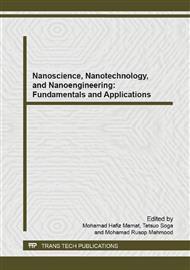[1]
Y. Cui, X. Duan, J. Hu, C. M. Lieber, Doping and Electrical Transport in Silicon Nanowires, J. Phys. Chem. B. 104 (2000) 5213.
DOI: 10.1021/jp0009305
Google Scholar
[2]
M. Scheffler, S. Nadj-Perge, L. P. Kouwenhoven, M. T. Borgstrom, E. P. A. M. Bakkers, Diameter-dependent conductance of InAs nanowires, J. Apply. Phys. 106 (2009) 124303.
DOI: 10.1063/1.3270259
Google Scholar
[3]
M. Niebelschutz, V. Cimalla, O. Ambacher, T. Machleidt, J. Ristic and E. Calleja, Electrical performance of gallium nitride nanocolumns, Physica E. 37 (2007) 200-203.
DOI: 10.1016/j.physe.2006.10.007
Google Scholar
[4]
M. Rosnita, O. Zulkafli, S. Samsudi, W. Yussof, Morphological and electrical characterization of GaAs Nanowires, AIP Conference Proceeding (2009) 344-347.
Google Scholar
[5]
M. Rosnita, O. Zulkafli, S. Samsudi, W. Yussof, Vapor-liquid solid mechanism using gold colloids for the growth of GaAs nanowires, Journal of Fundamental Sciences (2008) 363-367.
Google Scholar
[6]
A. D.Schricker, F. M. Davidson, R.J. Wiacek and B. A. Korgel, Space charge limited currents and trap concentration in GaAs NWs, Nanotechnology 17 (2006) 2681-2688.
DOI: 10.1088/0957-4484/17/10/040
Google Scholar
[7]
X. Zhou, S. A. Dayeh, D. Aplin, D. Wang and E. T. Yu, Scanned electrical probe characterization of carrier transport behavior in InAs nanowires, J. Vac. Sci. Technol. B 24 (2006) 2036-2040.
DOI: 10.1116/1.2213267
Google Scholar
[8]
T. W. Odom, J. L. Huang, P. Kim and C. M. Lieber, Atomic structure and electronic properties of single-walled carbon nanotubes, Nature 391 (1998) 62-68.
DOI: 10.1038/34145
Google Scholar
[9]
Z. Zhang and B. Bullemer, Normalised differential conductivity and surface density of states in stimulated tunnelling spectroscopy, Thin Solid Films 264 (1995) 277 – 281.
DOI: 10.1016/0040-6090(94)05827-x
Google Scholar
[10]
A. G. Baca and C. I. H. Ashby, Fabrication of GaAs devices, 1 st edition, The Institution of Electrical Engineers, London, UK, 2005.
Google Scholar
[11]
L. V. Titova, T. B. Hoang, H. E. Jackson, L. M. Smith, J. M. Yarrison-Rice, Y. Kim, J. J. Hannah, H. H. Tan and C. Jagadish C, Temperature dependence of photoluminescence from single-core shell GaAs-AlGaAs NWs, Applied Physics Letters 89 (2006) 173126.
DOI: 10.1063/1.2364885
Google Scholar
[12]
G. P. Morgan, K. Ogawa, K. Hiruma, H. Kakibayashi and T. Katsuyama, Optical Characterisation of GaAs quantum wire microcrystal, Solid State Communication 80 (1991) 235-238.
DOI: 10.1016/0038-1098(91)90188-2
Google Scholar


